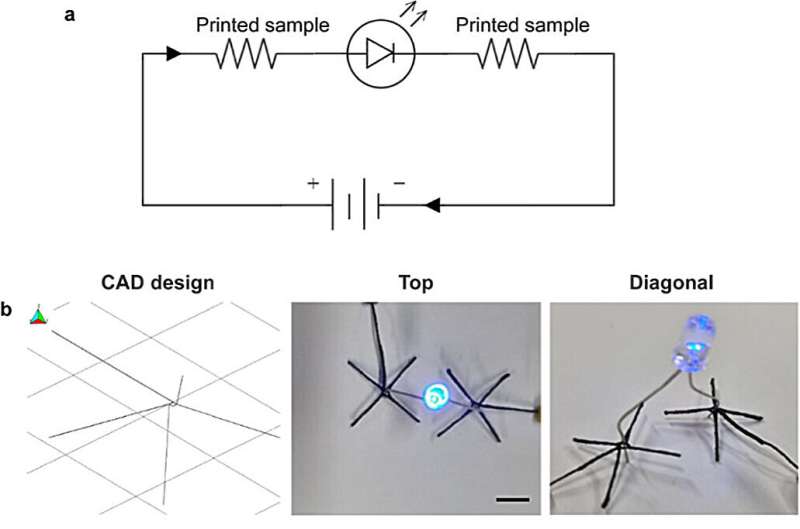3D printing method turns biodegradable polymers into conductive electronic components
From touch-sensitive smartphone screens to fitness wearables and wireless earbuds, electronics are becoming ever more integrated into our daily lives—and smaller, lighter, and more flexible in the process. But as the demand for electronic devices grows, so does the need for more sustainable ways to produce them.
That is the problem a research team led by Associate Professor Michinao Hashimoto from the Singapore University of Technology and Design (SUTD) set out to tackle. The team developed a novel 3D printing method that turns biodegradable materials into electrically conductive structures, which could inject a strong element of sustainability into various electronic components.
“As 3D printing advances, the technology isn’t just about shaping plastics anymore,” said Associate Professor Hashimoto. “It’s also about weaving in functionality, such as conductivity, to create devices directly from sustainable materials.”
In the paper, “Extrusion printing of electrically conductive polymer composites via immersion precipitation,” the team explored the use of cellulose acetate, a plant-derived plastic that is biodegradable and increasingly regarded as a greener alternative to synthetic polymers. However, printing with it has been far from simple. The study is published in the journal ACS Applied Engineering Materials.
Conventional extrusion-based printing methods, such as fused deposition modeling, rely on high heat—something cellulose acetate cannot withstand without degrading. Other methods like film casting lack the precision and flexibility required by digital fabrication.
To overcome this, the researchers turned to direct ink writing, which extrudes polymer inks at room temperature. Their custom ink combined cellulose acetate dissolved in acetone with graphite microparticles to achieve electrical conductivity. However, the ink spread too easily in air, leading to poor print definition due to the slow evaporation of acetone.
The breakthrough came when the researchers introduced a surrounding water medium. By extruding the ink directly into water, they initiated a process called immersion precipitation, where the water rapidly extracted acetone from the ink, which in turn solidified it in place. Importantly, this process prevented the material from spreading, enabling the formation of sharp, well-defined 3D structures.
“This is the first time immersion precipitation and 3D printing have been combined to realize conductive polymer composites,” explained Associate Professor Hashimoto. “It lets us print inks with a much higher filler content than usual, without clogging or structural collapse.”
Most printing methods struggle to handle conductive fillers above 30–50% by weight. Beyond that, nozzle clogging or loss of shape control becomes a problem. But with their immersion-based technique, the researchers were able to incorporate graphite concentrations of up to 60% while maintaining good printability and uniformity. The printed composites reached conductivities of over 30 S/m, sufficient to support applications such as flexible circuitry and soft sensors.
They also demonstrated how these printed composites could be used to complete electrical circuits, successfully powering light-emitting diodes (LEDs). To further showcase the versatility of their method, they printed overhanging spiral structures into a gel-based support medium, where they achieved complex geometries without the need for traditional scaffolding or post-processing.
“The ability to print overhangs without support, using just a gel bath, really expands what we can do,” said Dr. Arunraj S/O Chidambaram, the leading author of the paper. “It’s a more elegant and efficient approach than printing sacrificial structures and removing them later.”
Environmental sustainability was the main driving force behind the project. Cellulose acetate and graphite are both biodegradable and widely available. Acetone, the solvent used in the ink, is low in toxicity and degrades easily in soil and water. Combining these materials enables the team to offer a viable route towards electronics manufacturing that comes with a smaller environmental footprint.
The team intends to adapt the approach for other polymer–filler combinations and testing how their printed materials perform in real-world conditions over time. The overarching goal is to create a scalable, low-cost platform for producing sustainable, high-performance devices.
Associate Professor Hashimoto added, “By tuning the material properties and refining the process, we aim to build a full library of printable, functional composites tailored for specific applications—whether it’s wearable tech, biosensors, or flexible circuits.”
More information:
Arunraj Chidambaram et al, Extrusion Printing of Electrically Conductive Polymer Composites via Immersion Precipitation, ACS Applied Engineering Materials (2025). DOI: 10.1021/acsaenm.4c00685
Singapore University of Technology and Design
Citation:
3D printing method turns biodegradable polymers into conductive electronic components (2025, July 10)
retrieved 11 July 2025
from https://techxplore.com/news/2025-07-3d-method-biodegradable-polymers-electronic.html
This document is subject to copyright. Apart from any fair dealing for the purpose of private study or research, no
part may be reproduced without the written permission. The content is provided for information purposes only.

Comments are closed